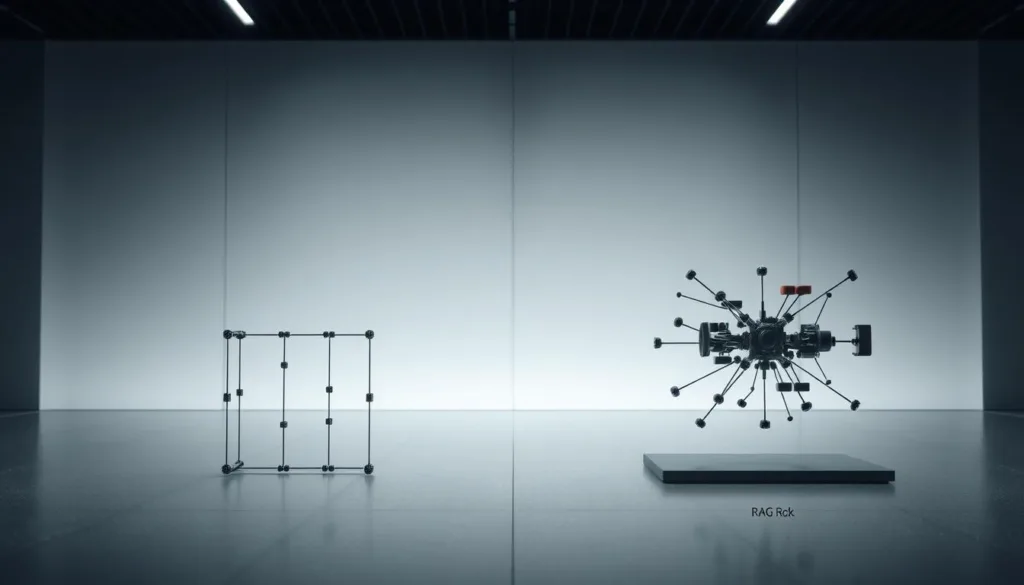Differences between traditional RAG and agentic adaptive RAG RAG systems have changed how we find information. Traditional RAG and agentic adaptive RAG are two main types. Knowing the differences between them is key to making good choices. Traditional RAG is common, but agentic adaptive RAG is becoming more popular because of its advanced features.

Understanding these differences helps us pick the right system for our needs. Both traditional RAG and agentic adaptive RAG have their own strengths and weaknesses. By knowing the differences, we can make better choices. This article will help you understand the main differences between these two RAG systems.
Key Takeaways
- Traditional RAG and agentic adaptive RAG are two distinct approaches to RAG systems.
- Understanding the key differences between these systems is crucial for making informed decisions.
- RAG systems, including traditional RAG and agentic adaptive RAG, offer unique benefits and drawbacks.
- Agentic adaptive RAG is gaining popularity due to its advanced capabilities.
- Choosing the most suitable system depends on specific needs and requirements.
- RAG systems have revolutionized the way we approach information retrieval.
Understanding the Foundations of RAG Systems
Differences between traditional RAG and agentic adaptive RAG RAG systems have been key in information retrieval for years. Traditional RAG is the base for newer systems. Knowing the core parts of these systems is vital. The evolution of RAG technology has brought big improvements, making info retrieval better.
The heart of RAG systems are core components that help find information. These parts include storing data, processing queries, and ranking results. The traditional RAG method focuses on these, laying a strong base for newer systems. As RAG tech grows, understanding these parts is key to innovation.
The main parts of RAG systems are:
- Data storage: keeping data organized and easy to find
- Query processing: making queries work to find the right info
- Result ranking: sorting results to show the most relevant first
Differences between traditional RAG and agentic adaptive RAGIn summary, RAG systems, from traditional RAG to newer versions, depend on core components for info retrieval. The evolution of RAG technology has made these systems much better. By knowing how RAG systems work, we can see the progress in RAG tech and its uses in many areas.
The Emergence of Agentic Adaptive RAG
Differences between traditional RAG and agentic adaptive RAG The emergence of agentic adaptive RAG has changed RAG systems a lot. This new method makes RAG systems more dynamic and able to learn from experience. They can now adapt to new situations better.
Differences between traditional RAG and agentic adaptive RAG Agentic adaptive RAG lets systems self-organize and self-adapt. This means they can handle complex and uncertain situations more effectively. Advanced algorithms help them learn and get better over time.
Some key benefits of agentic adaptive RAG are: Differences between traditional RAG and agentic adaptive RAG
- Improved flexibility and resilience in changing conditions
- Enhanced learning and adaptation abilities
- Increased autonomy and self-organization
The rise of agentic adaptive RAG is big for RAG systems. It makes them smarter and more responsive to user needs. As RAG systems keep growing, we’ll see even more advanced uses of agentic adaptive RAG.
Key Differences Between Traditional RAG and Agentic Adaptive RAG
Differences between traditional RAG and agentic adaptive RAG Traditional RAG and agentic adaptive RAG differ mainly in their design. Traditional RAG has a fixed setup, while agentic adaptive RAG is more flexible. This flexibility makes agentic adaptive RAG better at adapting to changes, leading to more efficient work.
Architectural Distinctions
Agentic adaptive RAG systems are more independent than traditional RAG. They can make decisions and adjust to new situations without needing a person to tell them what to do. Traditional RAG, however, needs more human help and input.
Processing Capabilities
Differences between traditional RAG and agentic adaptive RAG Agentic adaptive RAG systems can handle information better than traditional RAG. They use new algorithms and learning machines to understand data and make choices. Traditional RAG, by contrast, uses older methods that are slower and less effective.
- Traditional RAG: fixed architecture, less autonomous, traditional processing methods
- Agentic Adaptive RAG: flexible architecture, more autonomous, advanced processing capabilities
Intelligence Models in Both RAG Systems
Intelligence models are key in RAG systems, helping them understand and analyze complex data. Traditional RAG systems rely on set rules and protocols. These models work well in structured settings but lack flexibility.
Differences between traditional RAG and agentic adaptive RAG Agentic adaptive RAG systems, however, use more advanced models. These models can learn and adjust to new situations. They make decisions based on current data and changing conditions. This makes them better for dynamic environments.
Differences between traditional RAG and agentic adaptive RAG Intelligence models in RAG systems have big implications for their use in different fields. Some important features include:
- Ability to process complex data
- Adaptability to new situations
- Decision-making capabilities
Knowing about the intelligence models in traditional and agentic adaptive RAG systems helps us see their strengths and weaknesses. This knowledge guides the creation of more effective RAG systems.
Performance Metrics and Efficiency Comparison
Differences between traditional RAG and agentic adaptive RAG When we look at how well traditional RAG and agentic adaptive RAG work, we need to check several key areas. We should look at how fast and accurate they are. These factors greatly affect how well the systems perform. By studying these, we can understand how each system works and make better choices about using them.
Differences between traditional RAG and agentic adaptive RAG Comparing traditional RAG and agentic adaptive RAG shows they handle information differently. Traditional RAG uses set rules, while agentic adaptive RAG uses machine learning to get better. This makes agentic adaptive RAG more efficient for complex tasks because it can improve over time.
- Speed: How quickly can the system retrieve and process information?
- Accuracy: How precise are the results, and how well do they match the user’s query?
- Resource utilization: What resources are required to operate the system, and how efficiently are they used?
- Scalability: Can the system handle increased loads and adapt to changing requirements?
Differences between traditional RAG and agentic adaptive RAG Looking at these metrics helps us see what each system is good at and what it struggles with. This is key in choosing the right system for our needs. Efficiency comparison is important for picking the best option for our tasks. By considering these points, we can make our information retrieval better.
Real-World Applications and Use Cases
Differences between traditional RAG and agentic adaptive RAG RAG systems are used in many fields like healthcare, finance, and education. They help make better decisions, improve customer service, and work more efficiently. Some examples include predictive maintenance, personalized marketing, and smart tutoring.
In healthcare, RAG systems analyze patient data to suggest treatments. In finance, they spot fraud and forecast market changes. In education, they create learning plans that fit each student’s needs.
Here are some examples of RAG systems in action:
- Predictive maintenance in manufacturing
- Personalized marketing in e-commerce
- Intelligent tutoring in online education
These examples show how RAG systems can change industries and our lives. As they grow, we’ll see even more ways they help us.

Implementation Challenges and Solutions
Differences between traditional RAG and agentic adaptive RAG Organizations often face challenges when setting up RAG systems. These can be technical, integration, or cost-related issues. Knowing these implementation challenges helps find effective solutions.
Common technical barriers include system compatibility, data quality, and infrastructure issues. To tackle these, upgrading infrastructure, checking data quality, and ensuring system compatibility are key steps.
Differences between traditional RAG and agentic adaptive RAG Integration issues can also pop up, especially when linking RAG systems with other apps. Clear integration plans, defined data formats, and thorough testing can help solve these problems.
Finally, cost considerations are crucial in RAG system implementation. It’s important to weigh the costs of setup, upkeep, and upgrades against the system’s benefits. By understanding these challenges and finding solutions, organizations can successfully implement RAG systems.
Future Perspectives and Development Potential
Differences between traditional RAG and agentic adaptive RAG RAG systems will keep shaping the world of information retrieval. With emerging trends like artificial intelligence and machine learning, their development potential is huge. They will adapt and grow with new user needs and tech.
The future perspectives of RAG systems are bright. They could help in natural language processing and computer vision. As they improve, they’ll better understand and answer complex questions. Their development potential also depends on working well with other tech.

- Improved natural language processing
- Enhanced machine learning algorithms
- Increased integration with other technologies and systems
These updates will make RAG systems more accurate and useful. The emerging trends in RAG systems are driving innovation. It’s important to keep up with these changes to stay ahead.
Best Practices for Choosing Between RAG Systems
Differences between traditional RAG and agentic adaptive RAG Choosing between RAG systems involves several key factors. Traditional RAG and agentic adaptive RAG have their own strengths and weaknesses. The right choice for your organization depends on your specific needs and goals. It’s crucial to know the best practices for picking a RAG system.
Differences between traditional RAG and agentic adaptive RAG Consider the complexity level, adaptability needs, and available resources for setup and upkeep. By looking at these factors and the unique traits of traditional RAG and agentic adaptive RAG, you can pick the best fit for your organization.
Here are some tips for choosing between RAG systems:
- Assess your organization’s specific needs and goals
- Evaluate the level of complexity and adaptability required
- Consider the resources available for implementation and maintenance
- Compare the features and benefits of traditional RAG and agentic adaptive RAG
By following these best practices and carefully evaluating your options, you can make an informed decision. This way, you can choose the RAG system that best fits your organization’s needs.
Conclusion: Shaping the Future of Information Retrieval
Differences between traditional RAG and agentic adaptive RAG Exploring the differences between traditional RAG and agentic adaptive RAG shows a big change coming. Agentic adaptive RAG brings better processing, decision-making, and learning. This means a smarter and quicker way to find and use information.
Knowing these differences helps companies choose the right RAG for their needs. This choice is key to improving how we get and use information. As the industry grows, we’ll need more advanced and flexible solutions.
Differences between traditional RAG and agentic adaptive RAG Agentic adaptive RAG could change how we work with data. It could make us more productive and make better decisions. Keeping up with new trends and advancements is crucial. This way, our strategies stay ahead and meet the changing needs of information retrieval.
FAQ
What is the difference between traditional RAG and agentic adaptive RAG?
Traditional RAG systems are based on strict rules. Agentic adaptive RAG uses flexible, self-learning algorithms. This makes agentic adaptive RAG better at adapting to new situations and user needs.
What are the core components of RAG systems?
RAG systems have four main parts. These are the information retrieval engine, the knowledge base, the reasoning engine, and the user interface. Together, they help find and share information with users.
How has RAG technology evolved over time?
RAG technology has grown from simple rules to advanced machine learning. The new agentic adaptive RAG is a big step forward. It brings more flexibility, personalization, and learning.
What are the architectural distinctions between traditional RAG and agentic adaptive RAG?
Traditional RAG uses fixed knowledge bases and rule-based engines. Agentic adaptive RAG has dynamic knowledge and probabilistic engines. This makes agentic adaptive RAG more adaptable.
How do the processing capabilities differ between the two RAG systems?
Traditional RAG uses set algorithms and data. Agentic adaptive RAG uses machine learning to adjust its processing. This makes agentic adaptive RAG more flexible and responsive.
What are the key differences in the decision-making mechanisms of traditional RAG and agentic adaptive RAG?
Traditional RAG relies on fixed rules. Agentic adaptive RAG uses dynamic models that learn from users. This makes agentic adaptive RAG more adaptable to changing needs.
How do the learning adaptability features differ between the two RAG systems?
Traditional RAG needs manual updates. Agentic adaptive RAG learns from user interactions and changes. This makes agentic adaptive RAG more adaptable and improving over time.
What are the intelligence models used in both traditional RAG and agentic adaptive RAG?
Traditional RAG uses rule-based systems. Agentic adaptive RAG uses machine learning, like neural networks and natural language processing. This makes agentic adaptive RAG more advanced.
How do the performance metrics and efficiency compare between traditional RAG and agentic adaptive RAG?
Traditional RAG is fast and accurate in simple domains. But it struggles with complex situations. Agentic adaptive RAG is slower at first but gets better over time through learning.
What are some real-world applications and use cases of RAG systems?
RAG systems are used in many fields. They help with answering questions, managing information, and making decisions. They also offer personalized recommendations.
What are the key implementation challenges and solutions for RAG systems?
Implementing RAG systems can be hard. Challenges include technical issues, cost, and getting users to adopt them. Solutions include using cloud services, open-source tech, and training users.
What are the future perspectives and development potential of RAG systems?
RAG systems will get smarter with advancements in AI. They will understand and respond to users better. New trends include combining RAG with other AI technologies and creating more diverse knowledge bases.
What are the best practices for choosing between traditional RAG and agentic adaptive RAG?
Choose based on your needs and the situation. Traditional RAG is good for simple, stable areas. Agentic adaptive RAG is better for complex, changing environments.


Brilliant analysis! I’ve been using Image To Video for marketing and results are amazing! Image To Video adds such natural movement that viewers stay engaged longer.